
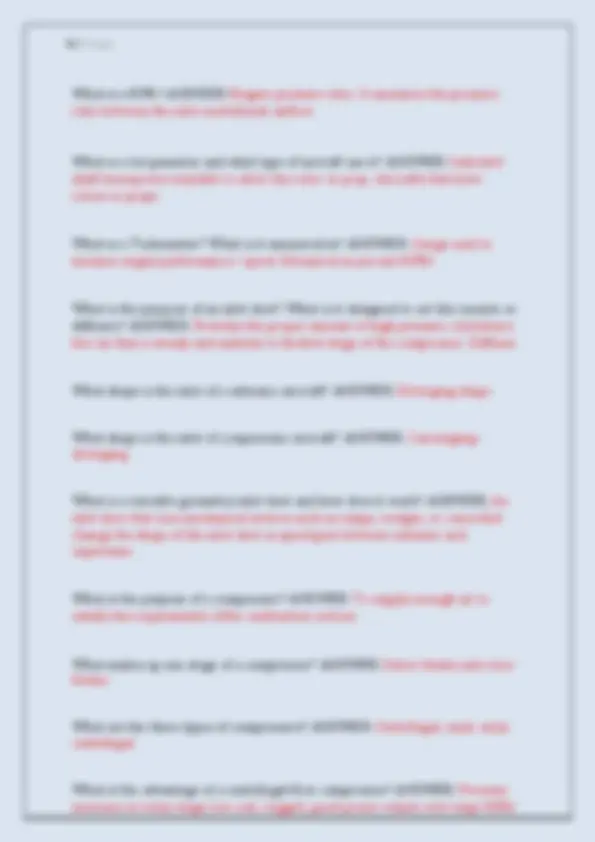
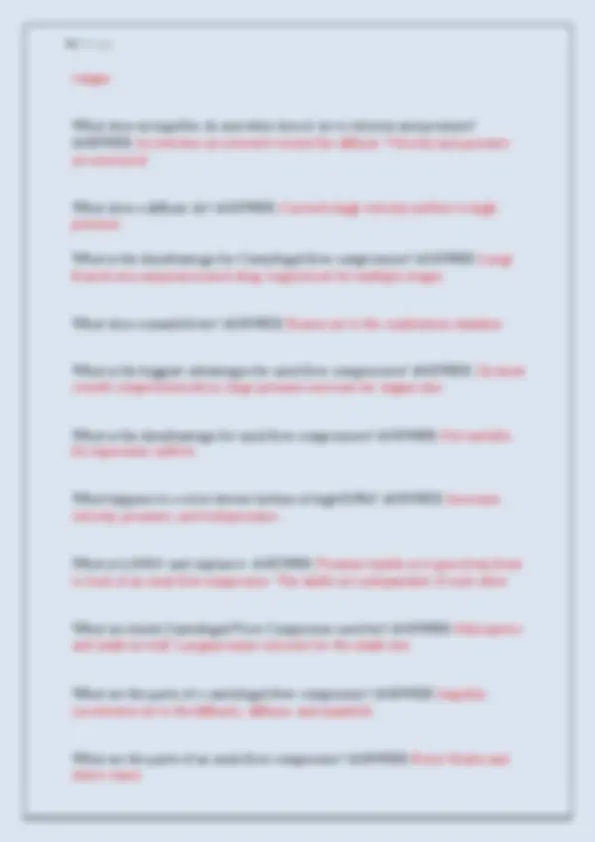
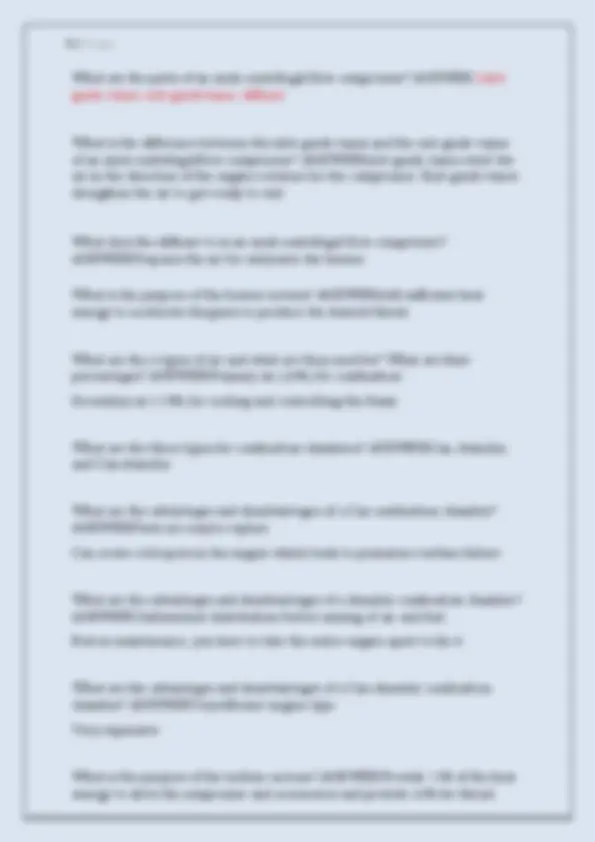
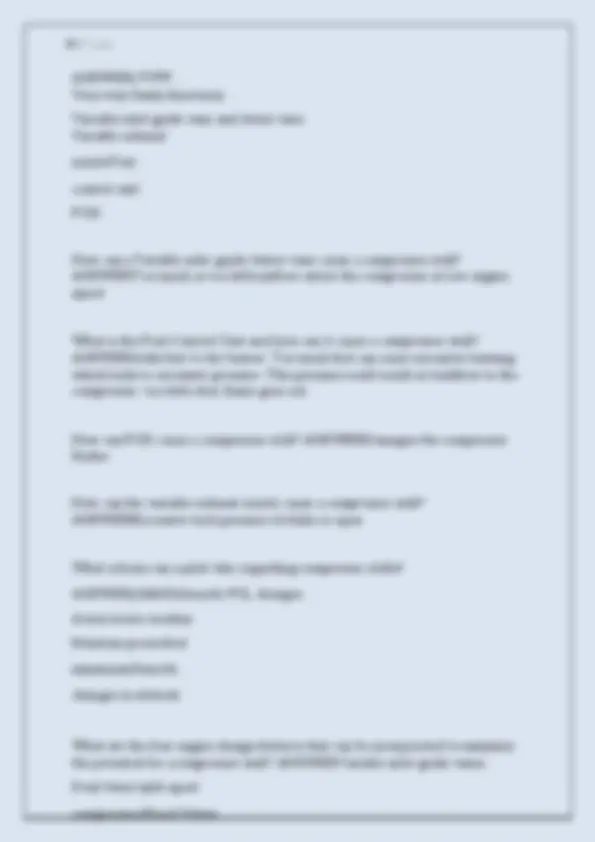
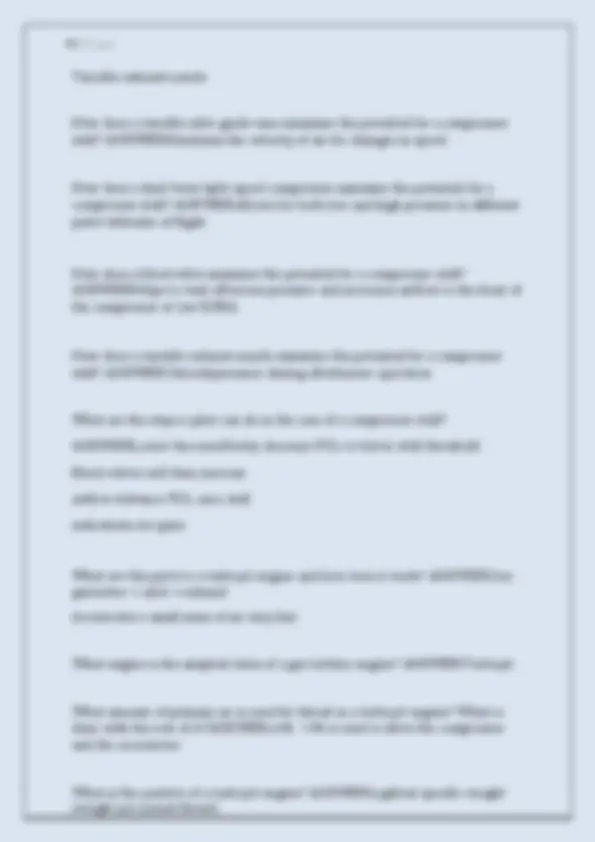
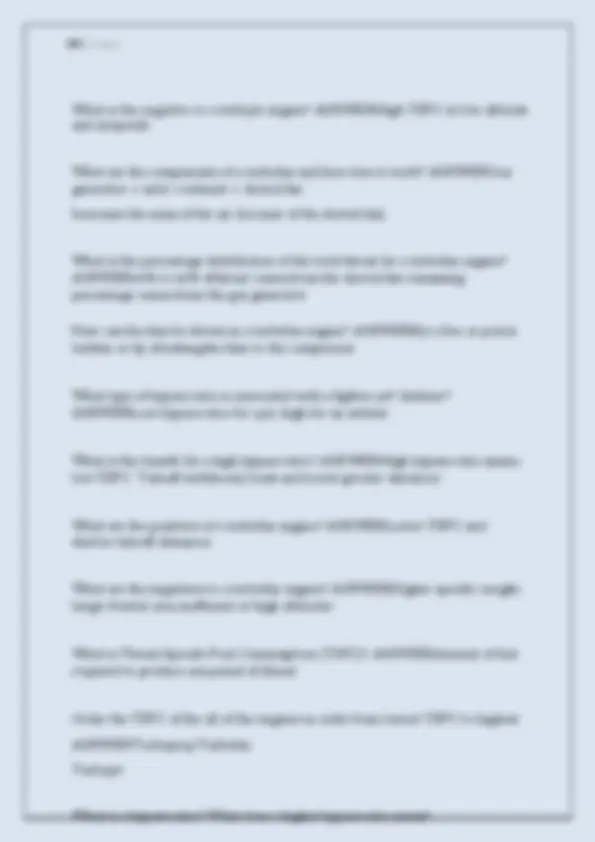
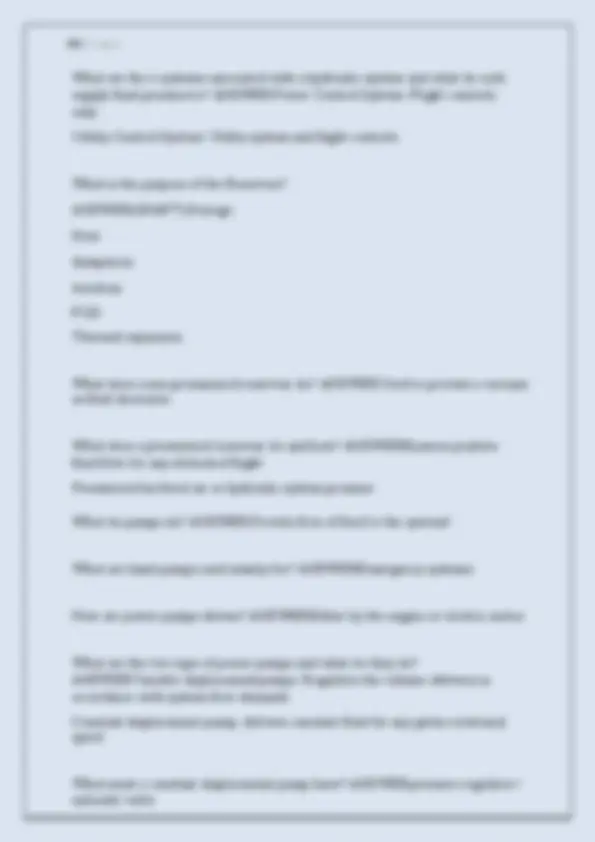
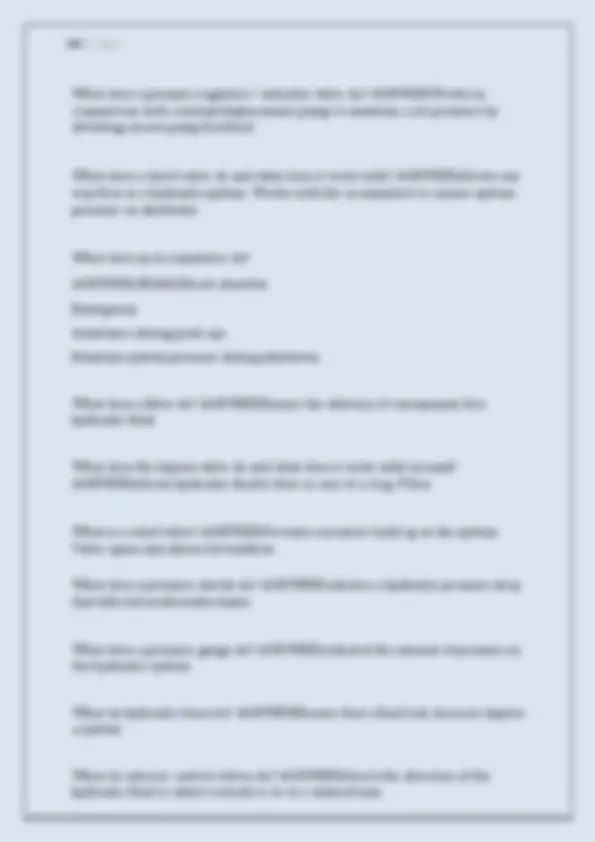
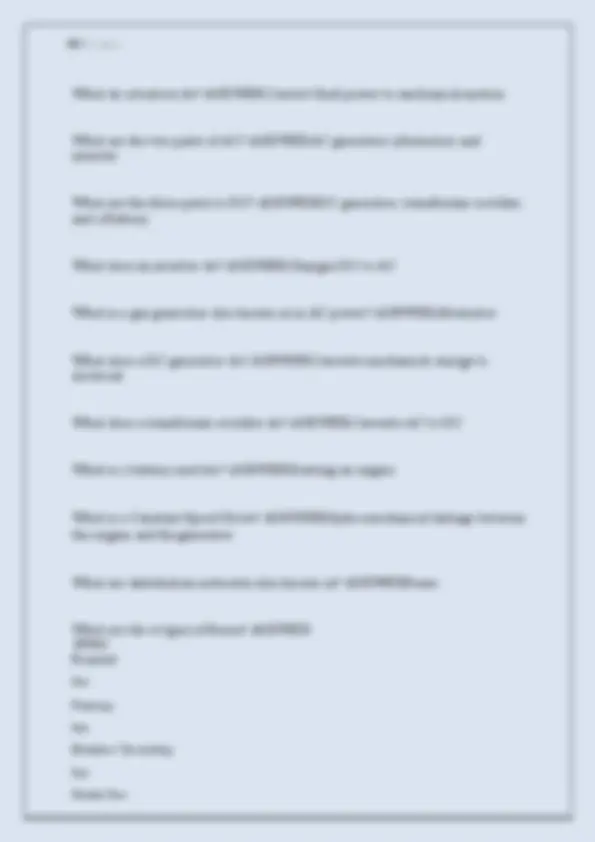
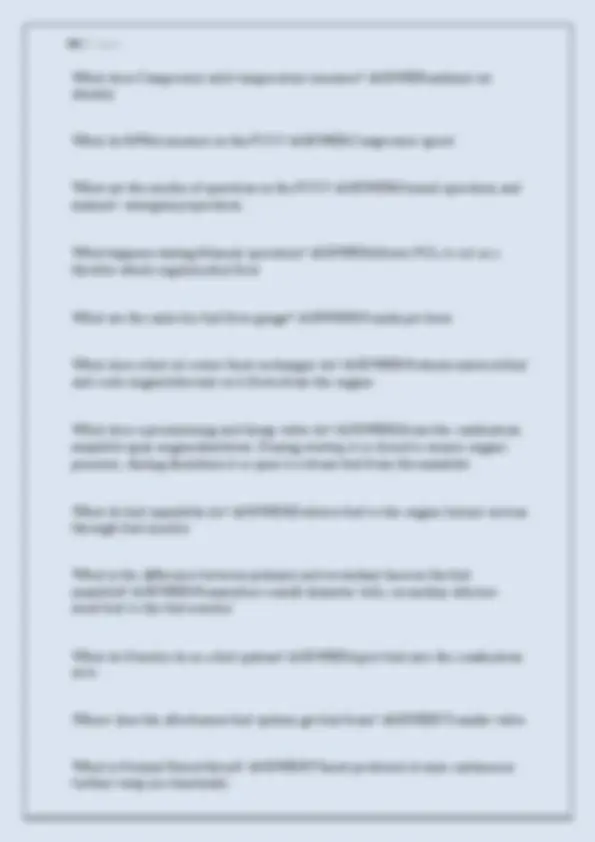
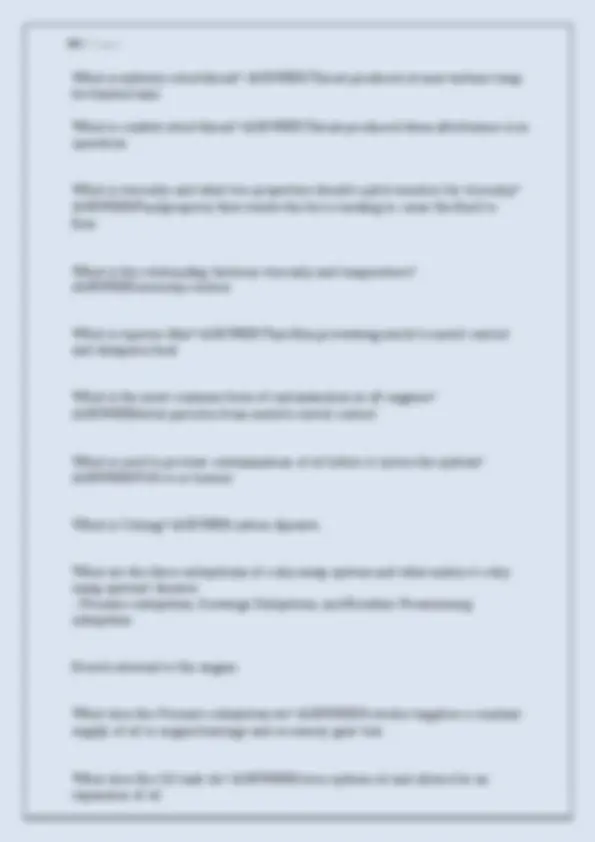
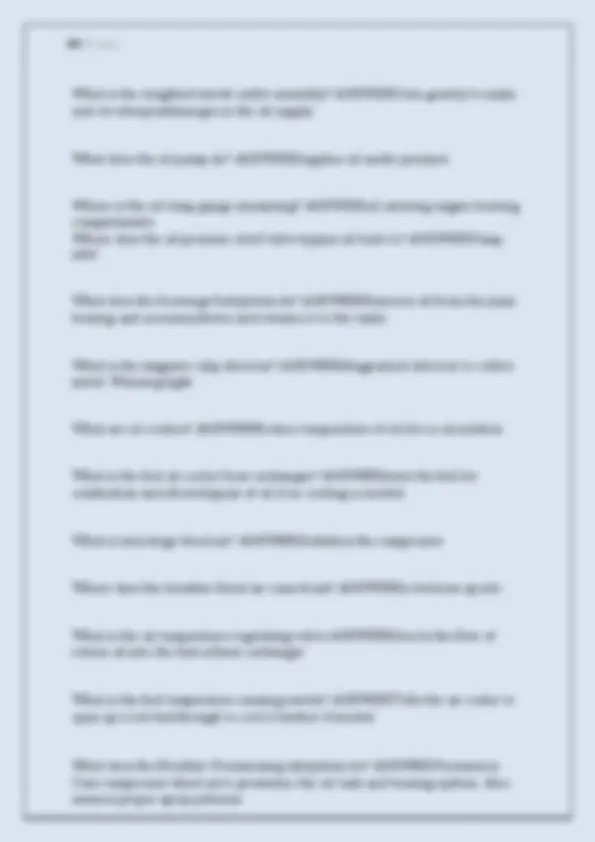
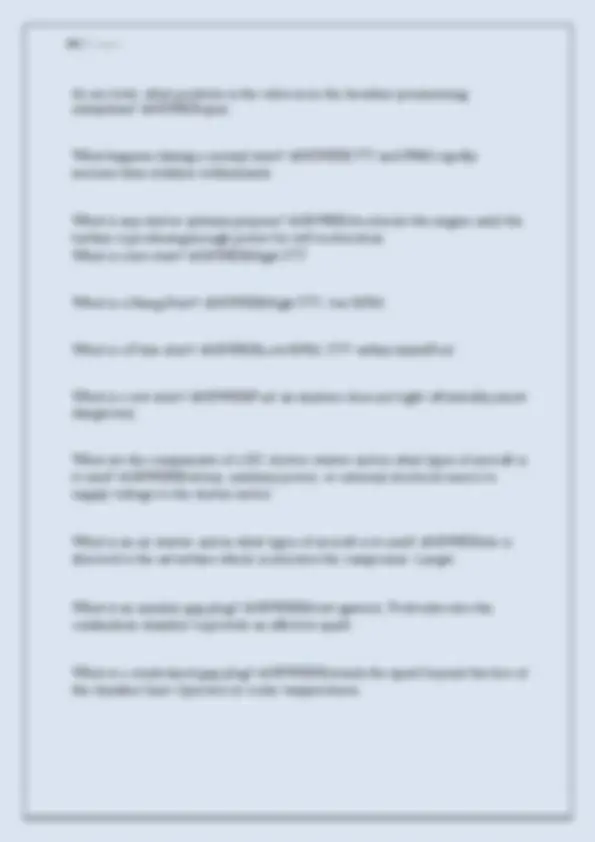


Study with the several resources on Docsity

Earn points by helping other students or get them with a premium plan


Prepare for your exams
Study with the several resources on Docsity

Earn points to download
Earn points by helping other students or get them with a premium plan
Community
Ask the community for help and clear up your study doubts
Discover the best universities in your country according to Docsity users
Free resources
Download our free guides on studying techniques, anxiety management strategies, and thesis advice from Docsity tutors
A comprehensive set of questions and answers related to gas turbine engines, covering topics such as bernoulli's theorem, compressor types, combustion chambers, and engine performance. It is a valuable resource for students preparing for the nife engines exam, offering insights into key concepts and principles.
Typology: Exams
1 / 21

This page cannot be seen from the preview
Don't miss anything!














What is Bernoulli's theorem ANSWER A ny incompressible fluid that passes through a convergent opening, velocity increase, pressure decreases What is Bernoulli's Equation ANSWER Pt=Ps+Pk Which type of air is compressible? ANSWE R Supersonic air What happens to Velocity and Pressure in a nozzle ANSWER Pressure decreases, velocity increases What happens to Velocity and Pressure in a diffuser? ANSWER Pressure increases, velocity decreases Draw the tootsie roll method ANSWER Left side are diffusers, right side are nozzles What does an increase in pressure at the inlet do for the engine? ANSWERIt packs more oxygen tighter together so the engine runs more efficiently What is the shape of the inlet? ANSWER Convergent-divergent What is the shape of an incompressible air diffuser? ANSWER Divergent What are the events/components of the Otto and the Brayton Cycle? ANSWER Intake, Compression, Combustion, Exhaust Explain what happens at each of the events in the Otto cycle A NSWER Intake: Air is entering the valve while the piston is at the bottom Compression: The pressure is increased as the piston moves up Combustion: Spark ignites the air and
sends the piston down Exhaust: the valve opens to release the air and start the cycle over What is the difference between the Otto and Brayton cycle? ANSWER All events happen simultaneously in the Brayton cycle, while they happen in order in the Otto cycle What three parts does a gas turbine engine have at a minimum? What else can also be included? ANSWER Compressor, Combustion Chamber/Burner, Turbine Inlet, Compressor, Diffuser, Combustion chamber/burner, Turbine, exhaust (I cant do complex turbine equations) What happens to temperature, pressure, and velocity at all 6 different parts of the gas turbine engine? Answer - What is gross thrust? ANSWER Thrust solely from the velocity of the exhaust gases (ignores inlet) at standard day conditions (29.92 in/Hg and 15C) What is net thrust and its equation? ANSWER Thrust that corrects for the inlet air. Net Thrust=m(Vf-Vi)/t What is the thrust equation? ANSWER* T=m*a Explain the RAM effect in a gas turbine engine ANSWER As the aircraft goes faster, more and more air is being rammed into the inlet. This increases the mass and pressure of the inlet air causing better engine performance. What are the cockpit thrust measuring devices? ANSWER EPR (Engine Pressure Ratio) gauge, Torquemeter, and Tachometer
ranges What does an impeller do and what does it do to velocity and pressure? ANSWER Accelerates air outward toward the diffuser. Velocity and pressure are increased. What does a diffuser do? ANSWER Converts high velocity airflow to high pressure What is the disadvantage for Centrifugal flow compressors? ANSWER Large frontal area means increased drag. Impractical for multiple stages. What does a manifold do? ANSWER Routes air to the combustion chamber What is the biggest advantages for axial flow compressors? ANSWER Greatest overall compression ratios, large pressure increase for engine size What is the disadvantage for axial flow compressors? ANSWER Not suitable for supersonic airflow. What happens to a rotor driven turbine at high RPM? ANSWER Increases velocity, pressure, and total pressure. What is LOHIO and explain it. ANSWER Pressure builds as it goes from front to back of an axial flow compressor. The shafts are independent of each other What are Axial-Centrifugal Flow Compressor used for? ANSWER Helicopters and small aircraft. Large pressure increase for the small size. What are the parts of a centrifugal flow compressor? ANSWER Impeller (accelerates air to the diffuser), diffuser, and manifold. What are the parts of an axial-flow compressor? ANSWER Rotor blades and stator vanes
What are the parts of an axial-centrifugal flow compressor? ANSWER Inlet guide vanes, exit guide vanes, diffuser. What is the difference between the inlet guide vanes and the exit guide vanes of an axial-centrifugal flow compressor? ANSWERInlet guide vanes swirl the air in the direction of the engine rotation for the compressor. Exit guide vanes straighten the air to get ready to exit. What does the diffuser to in an axial-centrifugal flow compressor? ANSWERPrepares the air for entry into the burner. What is the purpose of the burner section? ANSWERAdd sufficient heat energy to accelerate the gases to produce the desired thrust. What are the 2 types of air and what are they used for? What are their percentages? ANSWERPrimary air (25%) for combustion Secondary air (75%) for cooling and controlling the flame What are the three types for combustion chambers? ANSWERCan, Annular, and Can-Annular What are the advantages and disadvantages of a Can combustion chamber? ANSWERParts are easy to replace. Can create cold spots in the engine which leads to premature turbine failure What are the advantages and disadvantages of a Annular combustion chamber? ANSWERUniform heat distribution/better mixing of air and fuel. Bad on maintenance, you have to take the entire engine apart to fix it. What are the advantages and disadvantages of a Can-Annular combustion chamber? ANSWERVery efficient engine type Very expensive What is the purpose of the turbine section? ANSWERProvide 75% of the heat energy to drive the compressor and accessories and provide 25% for thrust.
What are spray bars and what percentage of extra fuel is used for what percentage of thrust increase ANSWERIntroduce fuel to the afterburner. 300% fuel increase for 50% thrust increase. What is a flame holder? ANSWERAllows for proper mixing of fuel and air for combustion. STABILIZES THE FLAME What is a screech liner? ANSWERPerforated sleeves to reduce pressure fluctuation and vibrations. Acts as a shock absorber. What is a variable exhaust nozzle ANSWERWay of changing the nozzle to create a convergent- divergent shape needed for supersonic speeds What are the parts to a basic light civilian aircraft reciprocating engine? ANSWERCrankcase, cylinders, pistons, connecting rods, valves, valve operating mechanism, crankshaft. (4 C's, 2 V's, a piston, and a spark plug) What is relative wind? ANSWERWind formed between the compressor RPM and inlet airflow What is angle of attack? ANSWERAngle between relative wind and the rotor blades chordline What is a compressor stall? ANSWERReduction of airflow to the turbines What are the indications of a severe compressor stall? ANSWERLoud bang, RPM decrease, ITT increase (LRI) Regarless of PCL movement What are compressor stalls usually the result of? ANSWERAirflow distortion or mechanical malfunction What are the four mechanical malfunctions that can lead to a compressor stall?
Very very funky functions) Variable inlet guide vane and stator vane Variable exhaust nozzle Fuel control unit FOD How can a Variable inlet guide/stator vane cause a compressor stall? ANSWERToo much or too little airflow enters the compressor at low engine speed What is the Fuel Control Unit and how can it cause a compressor stall? ANSWERAdds fuel to the burner. Too much fuel can cause excessive burning which leads to excessive pressure. This pressure could result in backflow to the compressor. too little fuel, flame goes out How can FOD cause a compressor stall? ANSWERDamages the compressor blades. How can the variable exhaust nozzle cause a compressor stall? ANSWERExcessive back pressure if it fails to open What actions can a pilot take regarding compressor stalls? ANSWER(SAMS) Smooth PCL changes Avoid severe weather Maintain prescribed minimums Smooth changes in attitude What are the four engine design features that can be incorporated to minimize the potential for a compressor stall? ANSWERVariable inlet guide vanes Dual/twin/split-spool compressors Bleed Valves
What is the negative to a turbojet engine? ANSWERHigh TSFC at low altitude and airspeeds What are the components of a turbofan and how does it work? ANSWERGas generator + inlet + exhaust + ducted fan Increases the mass of the air (because of the ducted fan) What is the percentage distribution of the total thrust for a turbofan engine? ANSWER30% to 60% of thrust comes from the ducted fan remaining percentage comes from the gas generator How can the fans be driven in a turbofan engine? ANSWERBy a free or power turbine or by attaching the fans to the compressor What type of bypass ratio is associated with a fighter jet? Airliner? ANSWERLow bypass ratio for a jet, high for an airliner What is the benefit for a high bypass ratio? ANSWERHigh bypass ratio means low TSFC. Takeoff with heavy loads and travel greater distances What are the positives of a turbofan engine? ANSWERLower TSFC and shorter takeoff distances What are the negatives to a turbofan engine? ANSWERHigher specific weight, larger frontal area, inefficient at high altitudes What is Thrust Specific Fuel Consumption (TSFC)? ANSWERAmount of fuel required to produce one pound of thrust Order the TSFC of the all of the engines in order from lowest TSFC to highest ANSWERTurboprop Turbofan Turbojet What is a bypass ratio? What does a higher bypass ratio mean?
ANSWERNumber of molecules that bypass the gas generator vs how many go in. Higher bypass ratio, lower TSFC What are the parts of a turboprop engine? ANSWERGas generator, reduction gear box, torquemeter, and propeller How does a turboprop engine produce its thrust? ANSWERPropeller imparts a small acceleration to large mass of air What is the percentage distribution of thrust in a turboprop engine? ANSWER90% propeller 10% exhaust/gas generator What are the parts to a propeller? ANSWERBlades, hub, and pitch change/dome assembly What does the dome assembly do? ANSWERChanges the pitch of the blades to increase or decrease in thrust How can the propeller be attached? ANSWEREither to the front of the compressor drive shaft or the free/power turbines What does the Reduction gear box do in a turboprop engine and why is it needed? ANSWERConverts high RPM and low torque to low RPM and high torque. Needed to protect the propeller from reaching supersonic speeds What does the torquemeter assembly do and what are its parts? ANSWERTransmit and measure power output from the gas generator to the reduction gear box. Parts are the torque shaft (carries load from prop and measures twist) and the reference shaft What units is the torquemeter measured in? ANSWERInch pounds of torque What is the alpha range? ANSWERIdle to forward (plane moves forward)
What are the 2 systems associated with a hydraulic system and what do each supply fluid pressure to? ANSWERPower Control System: Flight controls only Utility Control System: Utility system and flight controls What is the purpose of the Reservoir? ANSWER(SHAFT) Storage Heat dissipation Aeration FOD Thermal expansion What does a non-pressurized reservoir do? ANSWERUsed to prevent a vacuum as fluid decreases What does a pressurized reservoir do and how? ANSWEREnsures positive fluid flow for any attitude of flight Pressurized by bleed air or hydraulic system pressure What do pumps do? ANSWERProvide flow of fluid to the system? What are hand pumps used mainly for? ANSWEREmergency systems How are power pumps driven? ANSWEREither by the engine or electric motor. What are the two type of power pumps and what do they do? ANSWERVariable displacement pumps: Regulates the volume delivery in accordance with system flow demands Constant displacement pump: delivers constant fluid for any given rotational speed What must a constant displacement pump have? ANSWERpressure regulator/ unloader valve
What does a pressure regulator/ unloader valve do? ANSWERWorks in conjunction with constant displacement pump to maintain a set pressure by diverting excess pump flowback What does a check valve do and what does it work with? ANSWERAllows one way flow in a hydraulic system. Works with the accumulator to ensure system pressure on shutdown What does an Accumulator do? ANSWER(SEAM) Shock absorber Emergency Assistance during peak ops Maintain system pressure during shutdown What does a filter do? ANSWEREnsure the delivery of containment free hydraulic fluid. What does the bypass valve do and what does it work with/around? ANSWERAllows hydraulic fluid to flow in case of a clog. Filter What is a relief valve? ANSWERPrevents excessive build up in the system. Valve opens and allows for backflow What does a pressure switch do? ANSWERIndicates a hydraulic pressure drop that falls below allowable limits What does a pressure gauge do? ANSWERIndicated the amount of pressure in the hydraulic system What do hydraulic fuses do? ANSWEREnsure that a fluid leak does not deplete a system What do selector control valves do? ANSWERSelects the direction of the hydraulic fluid to where it needs to be at a desired time
What does an Essential Bus do? ANSWERRoutes power to equipment required for flight safety What does the Primary Bus do? ANSWERRoutes power to equipment for aircrafts mission What does a Monitor/ Secondary bus do? ANSWERRoutes power to convenience circuits What does a Starter Bus do? ANSWERRoutes power to start the aircraft's engine Switches, circuit breakers, and Fuses do what? ANSWERProvide manual or automatic control over the flow of electrical power What does a Switch do and what type of control does it use? ANSWERManual control, energize and de-energize a systems at the aircrew option What does a Circuit breaker do and how is it controlled? ANSWERManual or automatic. Interrupts power. Pop out if too high What do Fuses do and how are they controlled? ANSWERAutomatic. Circuit protection if an over- load or excessive current is flowing through something What does an Auxillary power unit do? ANSWERFrees the aircraft from being dependent on external power. Provides power through a driveshaft What are Ground Support units? ANSWERSupply regulated electrical power for different function of aircraft servicing What is Volatility? ANSWERAbility of a liquid to evaporate What is flashpoint? ANSWERLowest temperature at which a sufficient amount of vapor is given off by a liquid to form an ignitable mixture with it
What is the relationship between volatility and flashpoint? ANSWERHave inverse relationship What is JP-4's flashpoint and talk about its volatility? ANSWER-35F What is JP-5's flashpoint and talk about its volatility? ANSWER140F and low Volatility What is JP-8's flashpoint? ANSWER100F What are the colors of Avgas 100 and Avgas 100 LL ANSWERGreen and Blue What are the 2 most important considerations of designing a fuel system? ANSWERHigh rates of fuel flow and low atmospheric pressure What is the fuel tanks purpose? ANSWERStarting point for the fuel What does a fuel pump do? ANSWERSubmerged in the fuel tank, it ensures an adequate supply of fuel to the engine-driven fuel pump Where is the low pressure fuel filter located? ANSWERDownstream of the boost pump What does the Engine driven pump do? ANSWERDelivers fuel to the FCU and provides fuel in excess for engine requirements What are the FCU inputs? ANSWERCRIP Compressor Inlet Temperature RP Ms ITT PCL position
What is military rated thrust? ANSWERThrust produced at max turbine temp for limited time What is combat rated thrust? ANSWERThrust produced when afterburner is in operation What is viscosity and what two properties should a pilot monitor for viscosity? ANSWERFluid property that resists the force tending to cause the fluid to flow What is the relationship between viscosity and temperature? ANSWERInversely related What is squeeze film? ANSWERThin film preventing metal to metal contact and dissipates heat What is the most common form of contamination in all engines? ANSWERMetal particles from metal to metal contact What is used to prevent contamination of oil before it enters the system? ANSWERPON- 6 or bowser What is Coking? ANSWERcarbon diposits What are the three subsystems of a dry sump system and what makes it a dry sump system? Answer
What is the weighted swivel outlet assembly? ANSWERUses gravity to make sure its always submerges in the oil supply What does the oil pump do? ANSWERSupplies oil under pressure Where is the oil temp gauge measuring? ANSWERoil entering engine bearing compartments Where does the oil pressure relief valve bypass oil back to? ANSWERPump inlet What does the Scavenge Subsystem do? ANSWERRemoves oil from the main bearing and accessory drives and returns it to the tanks What is the magnetic chip detector? ANSWERMagnetized detector to collect metal. Warning light What are oil coolers? ANSWERReduce temperature of oil for re-circulation What is the fuel oil cooler/hear exchanger? ANSWERheats the fuel for combustion and allows bypass of oil if no cooling is needed What is interstage bleed air? ANSWERStabilizes the compressor Where does the breather bleed air come from? ANSWERIn between spools What is the oil temperature regulating valve ANSWERDirects the flow of return oil into the fuel-oil heat exchanger What is the fuel temperature sensing switch? ANSWERTells the air cooler to open up to let fuel through to cool it further if needed What does the Breather Pressurizing subsystem do? ANSWERPressurizes. Uses compressor bleed air to pressurize the oil tank and bearing system. Also ensures proper spray patterns